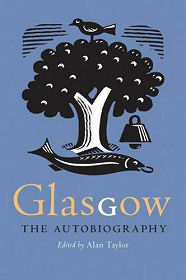 |
"Glasgow: The Autobiography" by Alan Taylor tells the story of Glasgow, once the "second city of the British Empire", and now by some margin the largest city in an increasingly confident and self-aware Scotland. It's not quite, as the title might suggest, told in the city's own words, but it does come pretty close in places. What we have here is a truly outstanding collection of pieces written about many different aspects of Glasgow by residents, visitors, journalists and commentators across the centuries. The book could equally have been called "Glasgow: A Compendium", but that wouldn't have quite the same ring and, perhaps more importantly, it wouldn't convey the same sense of Glasgow as a city with a personality of its own, separate from (but closely linked to) the personalities of those who live there, and who have lived there over recent centuries. Yes, if any city deserves "an autobiography", it is Glasgow.
The book is arranged chronologically, and begins with a 1597 account of witchcraft trials by John Spottiswoode; followed by a dictat issued by the Glasgow Kirk Session in 1604 about the appropriate head covering for women in church; an account of the city written in 1636 by the English visitor Sir William Brereton; and a poem entitled "O Glasgow!" written by John Barclay in 1685. We reach 1900 about a quarter of the way through the book, and the widely fluctuating fortunes of the city through the 20th Century from boom to bust ("Deserts Wi' Windaes"), and most of the way back again, provides much of the rest of the content. The sheer diversity of the sources is staggering, and it is the cumulative impact of all these differing points of view that builds up such an amazing portrait of a remarkable city.
We've seen books before that comprise collections of material about Glasgow, some of which have been very enjoyable. "Glasgow: The Autobiography" could be described in the same way, but stands out from other Glasgow books you are likely to find on the relevant shelf of your average Scottish bookshop. This is a book with an enduring quality that you feel you will want to return to again and again. In part that is down to the huge amount of effort the author has put into unearthing and selecting the material for it. Yes, the "usual suspects" like Thomas Pennant, Samuel Johnson, James Boswell and Dorothy Wordsworth have their views about the city included: it would have been obviously incomplete had they been omitted. But it's all the other contributors, some famous, some much less so, who really make this book sing.
There's one more thing that turns this book into a classic. On the cover, Alan Taylor is described as its editor. Yes, he has done the work in locating the material presented between the covers, but he has also done something else that is equally important. Every piece that is included comes with a introductory paragraph that sets what follows in context. In the case of some of the shorter contributions, the introduction can be longer than the piece itself. These introductions add hugely to the value and enjoyment of what we would have no hesitation in describing as the ideal book for anyone who lives or works in Glasgow, or has ever been to the city, or who has family roots there.
InformationHardcover: 320 pagesBirlinn Ltd birlinn.co.uk 1 September 2016 Language: English ISBN-10: 1780273533 ISBN-13: 978-1780273532 Size: 15.6 x 3.2 x 23.4 cm Buy from Amazon (paid link) Visit Bookshop Main Page |
